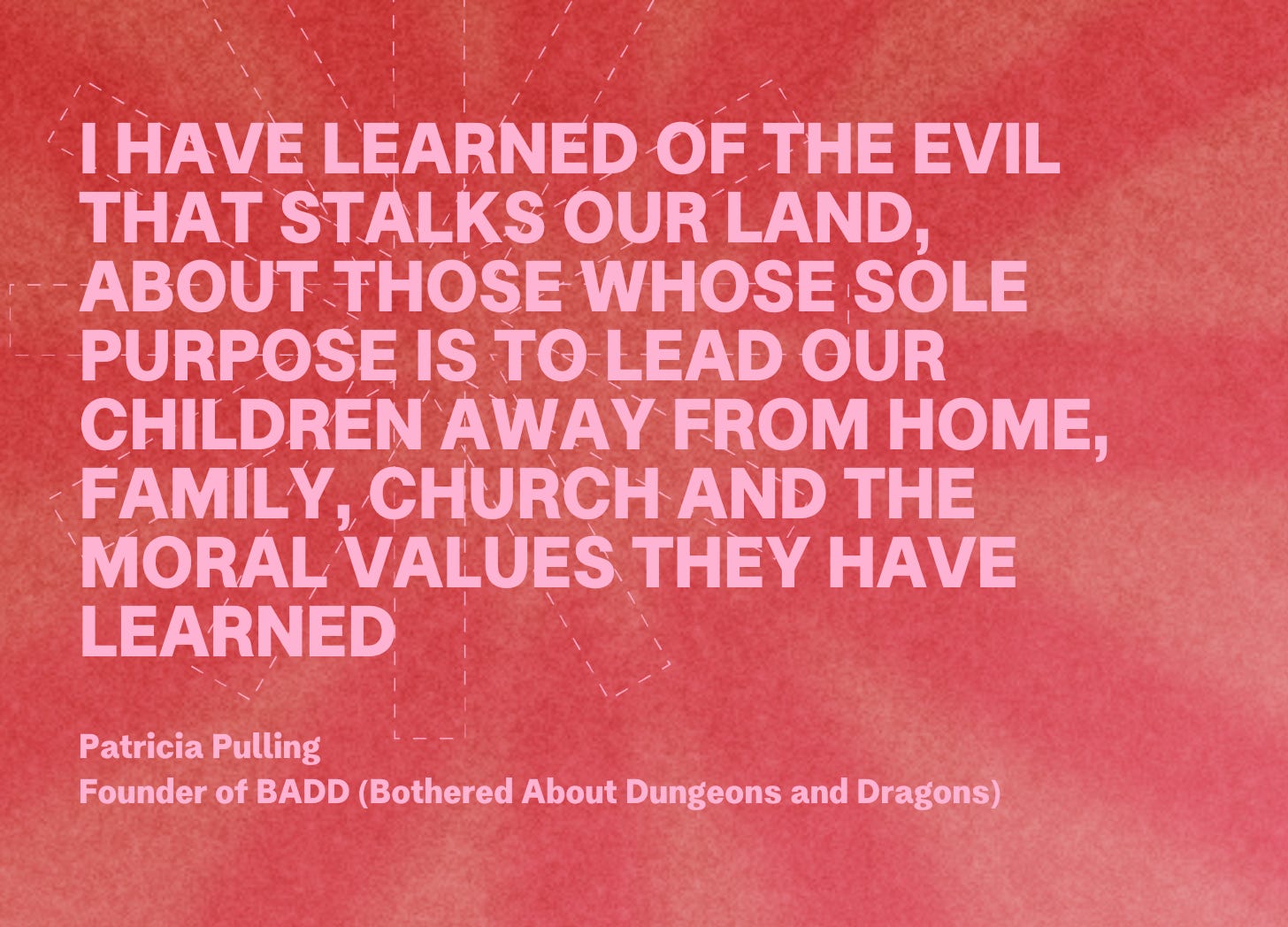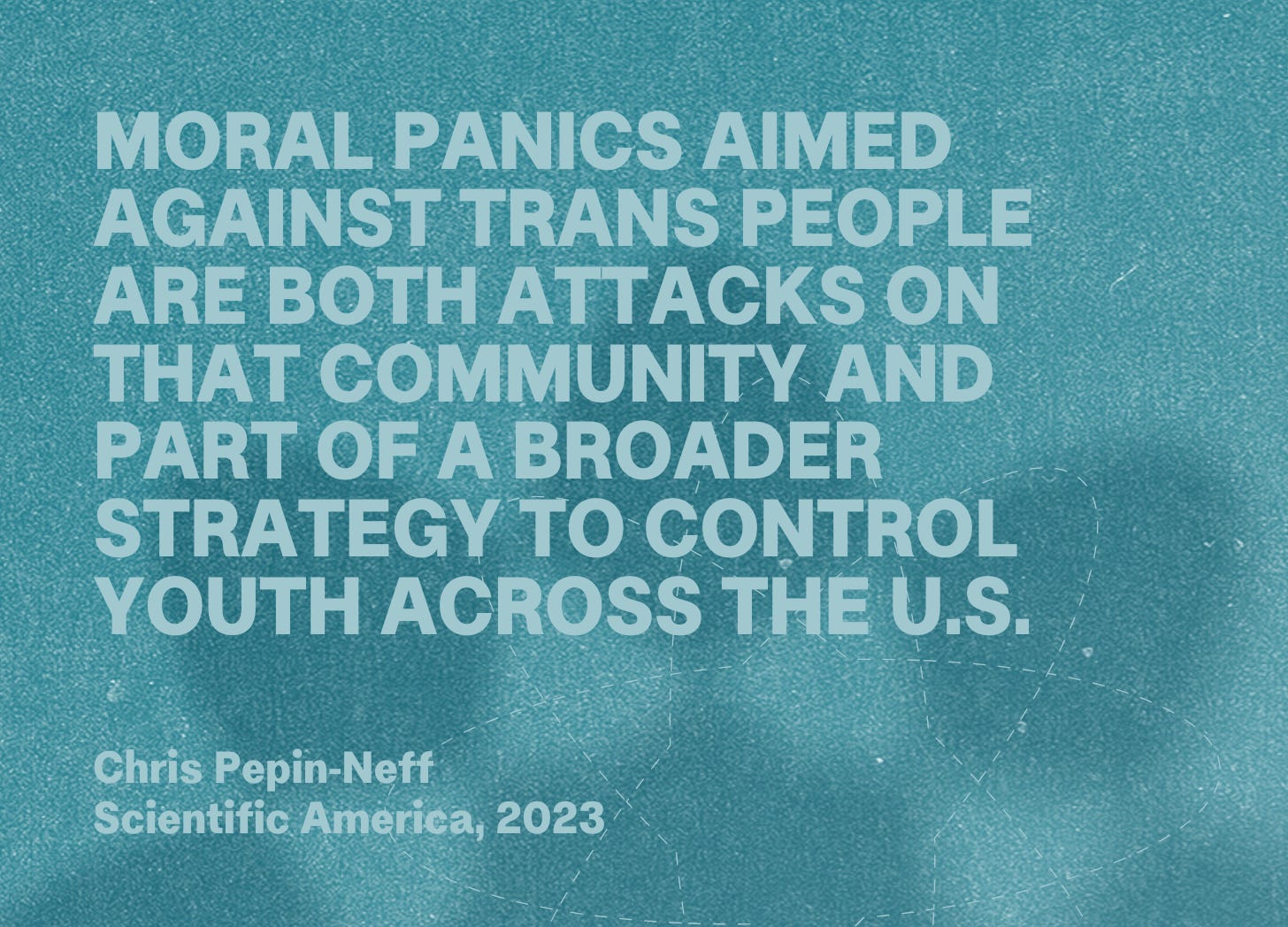Imaginary Monsters
In every generation, the danger isn’t the monster. It’s our need to invent one.
The year is 1985.
Parents pack school gymnasiums. Pastors rail from pulpits. News anchors speak with hushed urgency about a dark force corrupting America's youth.
The threat? A tabletop game involving graph paper, oddly-shaped dice, and pretending to be elves.
Fast-forward to now, and a new “threat to children” dominates headlines: transgender people, gender identity, and the supposed spread of “ideology” in classrooms and clinics.
The stakes are different, but the script feels familiar.
This is the anatomy of a moral panic.
When dragons were dangerous
For those who missed The Great Dungeons & Dragons Panic of the 1980s, here's a quick recap: D&D became popular as a fantasy role-playing game where players create characters who embark on imaginary adventures. It involved collaborative storytelling, basic math, and enough reading comprehension to understand that a "+2 sword of orc slaying" was better than your basic broadsword.
At the time, D&D was accused of promoting:
Satanism and witchcraft
Teen suicide
Violent behaviour
Detachment from reality
The undermining of Christian values
These claims were presented with deadly seriousness despite a stunning lack of evidence. The game was banned in schools, denounced from pulpits, and even featured in the TV movie "Mazes and Monsters," where a young Tom Hanks loses his mind because, apparently, pretending to cast Magic Missile was a gateway to psychosis.
Echoes of the same fear
The parallels become even more striking when we look at the actual rhetoric used during both controversies. Consider these statements from the D&D controversy:
"The game is like a cancer in our schools and community... It's a fantasy game which becomes a reality for many of those who play it." — Patricia Pulling, 1985
"We've had children who have taken their own lives... I feel the game contributed to their deaths." — Detective Pat Knapp in a 1985 press conference, despite no causal link being established
"Role-playing games like D&D can induce a dissociative state in which players lose touch with reality and mistake the game for real life." — Dr. Thomas Radecki, National Coalition on Television Violence, 1984
Now compare these to recent statements about transgender issues:
"This is nothing short of child abuse. We cannot allow our children to be indoctrinated from our schools." — Florida Governor Ron DeSantis, March 2022
"These doctors are permanently mutilating children in the name of profit... It's a social contagion among our youth." — Representative Marjorie Taylor Greene, October 2022
"They're recruiting and brainwashing children into their cult." — Matt Walsh, Daily Wire commentator, February 2023
"This ideology is being used to groom young children... Schools are forcing a woke gender ideology onto our kids." — Senator Ted Cruz, April 2023
Distinguishing between rhetoric and reality
To be clear, I'm comparing the mechanics of public discourse, not equating the experiences themselves. Being transgender involves core aspects of identity and personhood in ways fundamentally different from playing a game. The stakes are higher, and the consequences of these debates profoundly impact real lives, as we are seeing all too clearly at the moment.
Long-term studies show positive outcomes for transgender individuals who receive appropriate support, with significantly reduced rates of depression and suicidal ideation. Much of the media discourse ignores this data.
As GLAAD observed in a 2023 media review, "Trans people are more than theoretical curiosities to be debated from afar. Each and every anti-trans bill affects living, breathing people whose voices deserve to be heard and whose stories deserve to be told."
The complex reality behind the headlines
It's also important to acknowledge that within these broader cultural debates, there are people raising concerns that aren't merely driven by fear or prejudice. Many parents genuinely want to ensure their children receive appropriate care and support through complex developmental stages. Feminist scholars have long engaged with questions of gender, biology, and social structures in nuanced ways. Religious communities grapple with reconciling traditional teachings with evolving understandings of human experience.
The challenge is distinguishing between good-faith policy discussions and the hyperbolic rhetoric that often drowns them out. Careful consideration of complex ethical questions around medical care, particularly for young people, is entirely appropriate—but such discussions should be guided by evidence rather than alarm.
As Harvard Public Health noted, "The moral panic and hate-fueled backlash against gender-affirming care and trans people may seem to have erupted from nowhere. But it has deep historical precedent."
How moral panics follow the same script
What makes these rhetorical parallels more than just interesting historical footnotes is how predictably moral panics unfold and collapse.
Consider what happened with D&D:
Initial outrage based on misunderstanding
Media amplification generating more concern
"Experts" emerging to validate existing fears
Policy responses based on panic rather than evidence
Gradual normalisation as reality fails to match the dire predictions
Eventual acceptance (and in D&D's case, mainstream popularity - hello Stranger Things)
We've seen similar patterns with other supposed threats to youth: comic books in the 1950s, rock music in the 1960s, video games in the 1990s, and social media in recent years. Each sparked legitimate discussions about potential impacts on young people, but each also generated overheated rhetoric disconnected from observable reality.
Learning from yesterday's embarrassments
The D&D panic eventually became something most people were embarrassed to have participated in.
"Back then, I thought D&D would lead kids away from Christianity. Now my pastor's kid runs a campaign after Sunday school." — Former anti-D&D activist quoted in a 2016 gaming retrospective
"I testified at hearings trying to get that game banned. I never even read the rulebooks. I just heard things and got scared for my kids." — Parent interviewed in the 2019 documentary "Satanic Panic"
Former D&D opponents now sheepishly admit they never actually looked at the game materials or spoke with the players themselves. The question remains whether today's debates will follow a similar trajectory.
This isn’t new: A century of backlash
This is not a new phenomenon. Over a century ago, Magnus Hirschfeld, a pioneering German physician and sexologist, faced virulent backlash for his work advocating for homosexual and transgender rights. His Institute for Sexual Research in Berlin was one of the first to study and support trans people. In 1933, the Nazis raided the Institute, burned its extensive archives, and publicly vilified Hirschfeld. The moral panic then was about "degeneracy" corrupting Germany. Today, it’s about “grooming” or “ideological contagion.”

The language has changed, but the mechanisms remain familiar.
What these cultural moments really tell us
These cultural flashpoints reveal our collective anxieties about:
Changing social norms
Things we don't personally understand
Our children navigating a world different from the one we knew
Loss of cultural control
There's something almost comforting about moral panics. They offer simple villains for complex social changes. They provide the illusion that preventing one thing will somehow restore a simpler time that probably never existed anyway.
Finding common ground
Despite the heated rhetoric, I choose to believe that people across political divides share core values:
We want children to grow into healthy, authentic adults
We believe in protecting the vulnerable from harm
We value thoughtful, evidence-based approaches to complex issues
We recognise the dignity inherent in each person
The challenge is maintaining these principles when discussing topics that trigger our deepest anxieties about identity, faith, family, and the future.
Where do we go from here?
Perhaps the next time a cultural debate begins brewing, we might:
Ask who benefits from the outrage
Seek information directly from those being discussed, not just those discussing them
Consider whether the "threat" violates actual rights or just challenges our comfort
Remember our embarrassing track record of previous panics
Distinguish between legitimate policy questions and fear-based rhetoric
Insist on evidence over anecdote
The D&D kids of the 80s grew up just fine. Their character sheets didn't lead to moral decay—just as transgender people living authentic lives don't threaten society's foundations.
The real threat isn’t the thing we’re afraid of.
It’s how easily we abandon reason when fear comes knocking.
And looming even larger is how easily, and predictably, authoritarian regimes exploit moral panic for political power. We’re seeing this play out in real time. The Trump administration has stripped health protections from trans people, banned trans troops from the military, and laid the groundwork for further rollbacks of civil rights.
In every generation, the danger isn’t the monster. It’s our need to invent one. And the governments that are all too willing to weaponise that fear.





